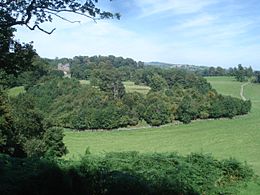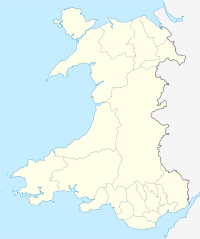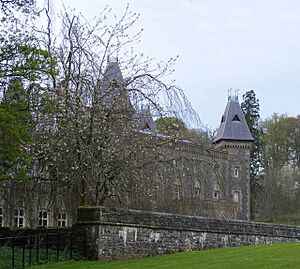Dinefwr Park National Nature Reserve facts for kids
Quick facts for kids Dinefwr Park |
|||||||||||
|---|---|---|---|---|---|---|---|---|---|---|---|
| National Nature Reserve | |||||||||||

Dinefwr Park
|
|||||||||||
| Location | Carmarthenshire, Wales | ||||||||||
| Nearest city | Llandeilo | ||||||||||
| Area | 800 acres (320 ha) | ||||||||||
| Established | 2007 | ||||||||||
| Governing body | National Trust | ||||||||||
|
|||||||||||
| Official name | Plas Dinefwr | ||||||||||
| Type | Grade I | ||||||||||
| Designated | 2002 | ||||||||||
| Reference no. | PGW (Dy) 12 (CAM) | ||||||||||
Dinefwr Park National Nature Reserve is a huge 800-acre estate in Carmarthenshire, Wales. It's near the town of Llandeilo. The National Trust owns this special place, which has a big old house called Newton House right in the middle. High up in the park, you can find the ruins of Dinefwr Castle. This castle was once very important to the ancient kingdom of Deheubarth.
Dinefwr Park is also a Grade I Historic Park. This means it's a very important historical garden. It's also a Site of Special Scientific Interest, which shows how important it is for nature.
Contents
What is Dinefwr Park?
Dinefwr Park is a special place that covers about 800 acres (which is like 600 football fields!). It's located in Carmarthenshire, Wales, not far from the town of Llandeilo. The National Trust looks after the park and the old house inside it.
This park is unique because it's the only parkland national nature reserve in Wales. It became a nature reserve in 2007.
Amazing Nature and Animals
Dinefwr Park is home to over 300 trees that are at least 400 years old! Imagine how much history those trees have seen. The park also has ancient fields where animals graze. You can enjoy beautiful views of the valley.
If you visit, you might spot fallow deer roaming freely. You can also see rare white park cattle. These special white cows have lived in this area for more than a thousand years! They even appear in the old Welsh laws of Hywel Dda.
The park gently slopes down to the flat fields near the River Tywi. Here, you'll find small lakes that add to the lovely scenery.
Newton House
Right in the middle of Dinefwr Park stands Newton House. This grand house was built on the site of an old medieval town that never quite took off. The current house was first built around 1660. Later, in the 1850s, it was completely rebuilt in a Victorian Gothic style.
The family who owned the estate sold it in 1972. The National Trust bought the deer park and nature reserve in 1986. Four years later, they also bought Newton House. Today, the house is open for people to visit and explore.
Dinefwr Castle
The ruins of Dinefwr Castle are also located within the park. They are found in an area called Castle Woods. The Wildlife Trust of South and West Wales has owned these woods since 1979.
The castle itself is looked after by Cadw, which is the Welsh government's historic environment service. This site has a very long history. It was first used by Rhodri the Great in the 9th century. Later, it became the main castle for the kingdom of Deheubarth. You can visit the castle ruins and imagine what life was like there long ago.
Also in the park's woods is St Tyfi's Church. This old church used to be the local parish church. It is a Grade II listed building, meaning it's an important historical building.
Roman Forts Discovered
In 2003, something very exciting was found at Dinefwr Park! During a special ground radar survey, the outlines of two Roman forts were discovered. These forts were built on top of each other.
More digging in 2005 showed that the older fort was quite large, about eight acres. It was built in the late 70s AD and could have held up to 2,000 soldiers! The second, smaller fort was about 3.5 acres and was used later as a garrison (a place for soldiers to live). This smaller fort also had a vicus nearby. A vicus was like a small village or settlement that grew up around a Roman fort.
These forts were built not long after the Romans conquered Wales. They were abandoned early in the 2nd century AD. It's amazing to think that Roman soldiers once lived and worked right here in Dinefwr Park!



